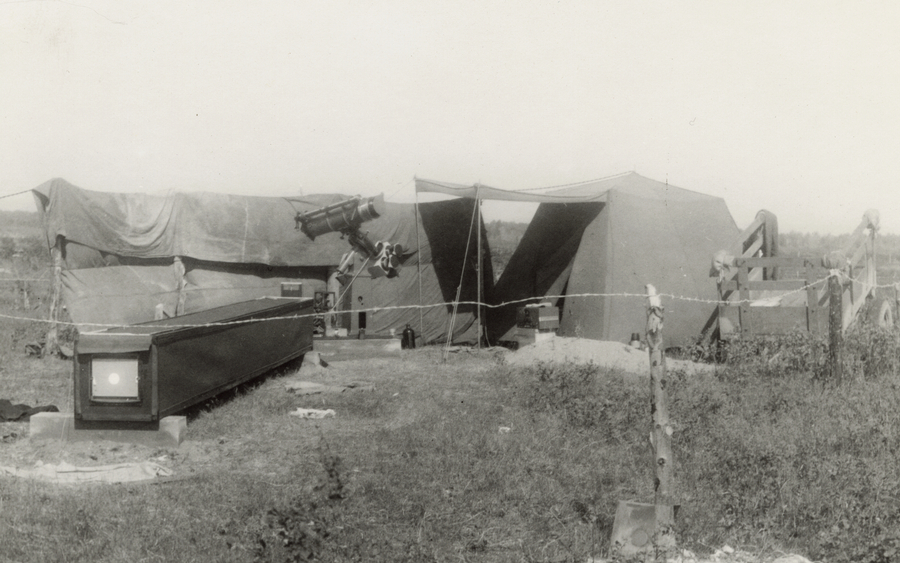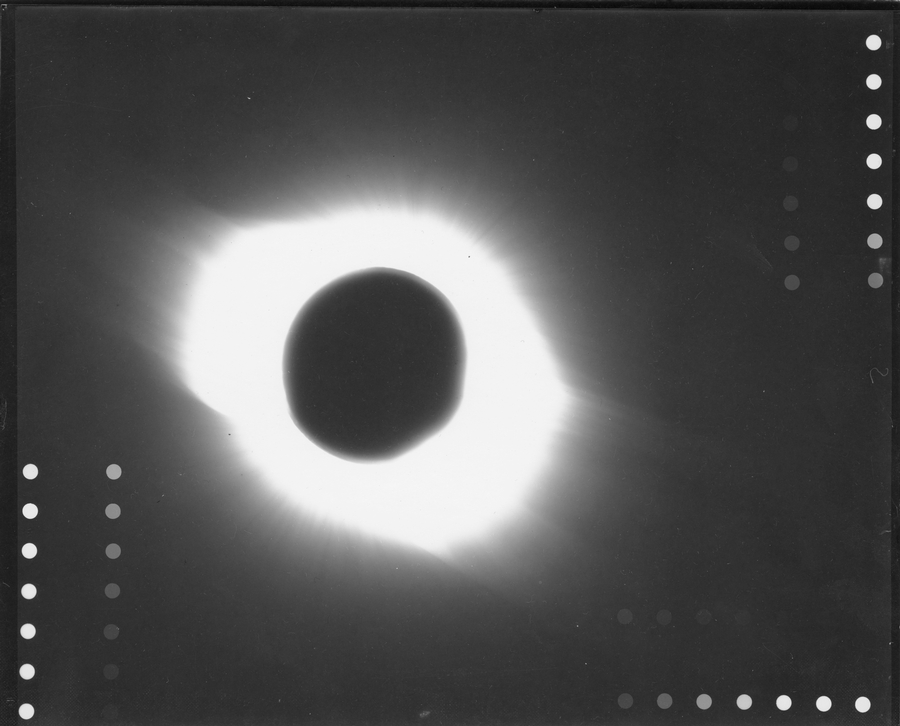  
|
Total Solar Eclipse of 1945 July 9
in northwestern USA, central Canada or Sweden
|
|
|
One exeligmos (three eclipses in a saros or a little over 54 years) before the 1999 August 11 total solar eclipse, the total solar eclipse on 1945 July 9 didn’t receive much attention on the part of American astronomers until a month or two before it occured. This was the natural consequence of several factors such as the war in Europe, the relative inaccessibility of the totality path, the comparatively short period of totality and the low altitude of the Sun at totality. In the few weeks preceding the date of the eclipse, word came from many quarters of eclipse expeditions which were being planned for various places along the path from Idaho to Hudson Bay. European astronomers had the same difficulties because of the war although the Sun was much higher in the sky, the totality duration longer and the weather prospects better.
Click on thumbnails for a larger version
|
|
|
Yerkes Observatory group near Pine River (Manitoba, Canada):
William A. Hiltner and Subrahmanyan Chandrasekhar from the Yerkes Observatory in Chicago decided in May 1945 to lead an expedition to Manitoba to record the total solar eclipse of July 9, 1945.
In view of the very short duration of the totality, 37 seconds in Pine River, it appeared to them that, for the sake of the completeness of the record, attemps should be made to secure both small-scale and large-scale photographs of the corona in order that both the outermost extensions of the corona and the structure of the inner parts could be studied. Two instruments were brought with them: a 6-inch UV telescope and a 4-inch doublet, corrected for the green and the blue, with a focal length of 20 feet. After some exploration the site was chosen on a slight ridge commanding a clear view of the eastern sky some five miles southeast of Pine River, that is about 0.7 miles south of the centerline.

Viewing location southeast of Pine River, Manitoba, in Canada
|
On July 9th morning the eastern sky was cloudy, but the drifting clouds produced a clear region some twenty-five minutes before totality. The entire sky clouded over again half an hour later. The instant of second contact occured at the predicted moment within a fraction of a second which isn’t surprising nowadays when looking at the lunar limb profile.

Lunar limb profile from the viewing location southeast of Pine River, Canada
|

Instruments at the viewing location southeast of Pine River, Canada
|

Chandrasekhar Subrahmanyan in front of the instruments
|
While these photographs resemble in many ways the earlier photographs taken during the minimum phase of solar activity and reveal, as could have been anticipated, an equatorial type of corona, it would appear that the streamers in the equatorial plane are perhaps more fully developed than in earlier photographs. It should perhaps be recorded in this connection that there was exceptional auroral activity during the days immediately preceding and following the date of the eclipse.




Solar corona from the viewing location southeast of Pine River, Canada
|
Princeton group near Malta (Montana, USA):
The "Princeton Party" (about 65 persons) and 46 collaborating volunteer groups (about 220 persons) were stationed from Oregon to Saskatchewan.
Successful photographs of the corona in color were made by the Freemans, two 16 mm motion picture films showed the inner corona during the whole of totality and the retreat at 3.5 miles a second of the Moon’s shadow near third contact accross broken clouds. The retreating shadow was shown also on a still color-photograph made by the Montana State University party at Saco. The procedure followed to secure a number of volunteer observers at this eclipse proved highly successful. A mimeographed questionnaire calling for certain observations was broadly distributed in advance, especially through the good offices of the Forest Service.

Viewing location southeast of Malta, Montana, in the USA
|
As second contact approached, the Sun climbed up into one of those miraculous little "windows" which occasionally serve eclipse observers, and shone in deep blue sky from 6:08am until totality began. There was no cirrus or other higher cloud but the photographs show broken clouds close to the Sun during totality, and the Sun disappeared into the upper altocumulus cloud bank at 6:19am. No one in the party saw Baily’s beads or prominences or shadow bands. The clocked duration was within a fraction of a second from the predicted duration which isn’t surprising nowadays when looking at the lunar limb profile. On the longest-exposed photograph, at about 4 diameters of the Sun to the upper right, Saturn shined through the broken clouds into which the Sun was climbing as the eclipse ended. The overcast was reported by the airplane observers to be at about 11,000 feet. Venus was the only planet or star seen at Malta, it was visible even before and after totality.

Lunar limb profile from the viewing location southeast of Malta, Montana, in the USA
The apparent diameters of the Sun and Moon being very close it isn’t surprising that observers could see the chromosphere all around the lunar limb: this what one can read in the daily Baltimore News-Post "Observers on an East Mountain lookout near Cascade, Idaho, were treated to a brillant display as the sun rose obliterated by the moon except for a fiery red corona, or ring, circling the moon’s edges. The outer corona was white.".

|
Philadelphia Bulletin - Franklin Institute - University of Pennsylvania group in Wolseley (Saskatchewan, Canada):
The planning of the eclipse expedition had been under way since October 1944.
Most of the instruments were borrowed from the Flower and Cook Observatories of the University of Pennsylvania.

Viewing location at the school of Wolseley, Saskatchewan, in Canada
|
The calculated duration of totality was 34 seconds, while the measured one was about 33 seconds, that is within a fraction of a second from the predicted duration which isn’t surprising nowadays when looking at the lunar limb profile.

Lunar limb profile from the viewing location at the school of Wolseley, Saskatchewan, in Canada
|
The program of observations was as follows: direct photograph of the outer corona in visual light with an objective of 18-foot focal length; photographs of the inner corona in visual light with an objective of 40-foot focal length; photograph of the outer corona in red (6.500Å) and green light (5.300Å) with fast cameras of 28-inch focal length; time-lapse motion pictures from first to fourth contact. The motion picture camera was to be fed by a small coelostat, unfortunately the camera failed to arrive in time.
Before dawn, clear skies were at hand, except for a thin low streak of cloud along the horizon from east through north to west. The Sun rose on a clear horizon, passed through the cloud streak, and rode well above it in a beautiful sky at totality. The weather conditions could not have been better at Wolseley, especially in view of the miserable clouds that prevailed at Bredenbury and at Roblin, farther along the path, where many expeditions were located.

Solar corona from the viewing location at Wolseley, Canada
|
Stockholm Observatory - Paris-Meudon Observatory group in Brattås (Sweden):
In normal times many eclipse expeditions should have occurred in Scandinavia. However during this difficult period, these expeditions were reduced to those of the various Swedish observatories, to a Danish mission and a French mission to which Bernard Lyot, inventor of the coronagraph in the 30s, participated. Lyot had also brought with him a polarimetric telescope.
Nonetheless, there was also a small Norwegian group in Norway, and a number of Soviet missions in the USSR. However these groups were obviously clouded out on eclipse day.
Outside of the path, ionospheric scientists at Tromsø, Norway, only two moths after the liberation, took the opportunity to measure the effects of the eclipse on the ionosphere. Their results showed a pronounced dip in the critical frequency during the eclipse. Interestingly, their report also noted that the Germans had an ionospheric station at Kjeller, used to determine radio communication frequencies after the war. When the station was taken over by Allied forces, the German personnel was ordered to continue their work, and observations were made at that station as well.

Viewing location at Brattås in Sweden
|
The measured duration of totality was visibly 63 seconds.

Lunar limb profile from the viewing location at Brattås in Sweden
|
All observations were performed properly. Negatives, spectra and movies showed, after development, encouraging images.

Solar corona from the viewing location at Brattås in Sweden

Bernard Lyot and his polarimetric telescope in Brattås, Sweden
|
|
|
|
|
|
|




















